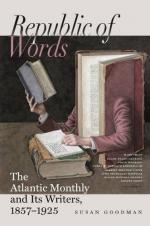Amidst so much that seems like death, let us turn and study the life. There is much more to be seen in winter than most of us have ever noticed. Far in the North the “moose-yards” are crowded and trampled, at this season, and the wolf and the deer run noiselessly a deadly race, as I have heard the hunters describe, upon the white surface of the gleaming lake. But the pond beneath our feet keeps its stores of life chiefly below its level platform, as the bright fishes in the basket of yon heavy-booted fisherman can tell. Yet the scattered tracks of mink and musk-rat beside the banks, of meadow-mice around the hay-stacks, of squirrels under the trees, of rabbits and partridges in the wood, show the warm life that is beating unseen, beneath fur or feathers, close beside us. The chicadees are chattering merrily in the upland grove, the blue-jays scream in the hemlock glade, the snow-bird mates the snow with its whiteness, and the robin contrasts with it his still ruddy breast. The weird and impenetrable crows, most talkative of birds and most uncommunicative, their very food at this season a mystery, are almost as numerous now as in summer. They always seem like some race of banished goblins, doing penance for some primeval and inscrutable transgression, and if any bird have a history, it is they. In the Spanish version of the tradition of King Arthur it is said that he fled from the weeping queens and the island valley of Avilion in the form of a crow; and hence it is said in “Don Quixote” that no Englishman will ever kill one.
The traces of the insects in the winter are prophetic,—from the delicate cocoon of some infinitesimal feathery thing which hangs upon the dry, starry calyx of the aster, to the large brown-paper parcel which hides in peasant garb the costly beauty of some gorgeous moth. But the hints of birds are retrospective. In each tree of this pasture, the very pasture where last spring we looked for nests and found them not among the deceitful foliage, the fragile domiciles now stand revealed. But where are the birds that filled them? Could the airy creatures nurtured in those nests have left permanently traced upon the air behind them their own bright summer flight, the whole atmosphere would be filled with interlacing lines and curves of gorgeous coloring, the centre of all being this forsaken bird’s-nest filled with snow.
Among the many birds which winter here, and the many insects which are called forth by a few days of thaw, not a few must die of cold or of fatigue amid the storms. Yet how few traces one sees of this mortality! Provision is made for it. Yonder a dead wasp has fallen on the snow, and the warmth of its body, or its power of reflecting a few small rays of light, is melting its little grave beneath it. With what a cleanly purity does Nature strive to withdraw all unsightly objects into her cemetery! Their own weight and lingering warmth take them through air or water, snow or ice, to the level of the earth, and there with spring comes an army of burying-insects, Necrophagi, in a livery of red and black, to dig a grave beneath every one, and not a sparrow falleth to the ground without knowledge. The tiny remains thus disappear from the surface, and the dry leaves are soon spread above these Children in the Wood.




